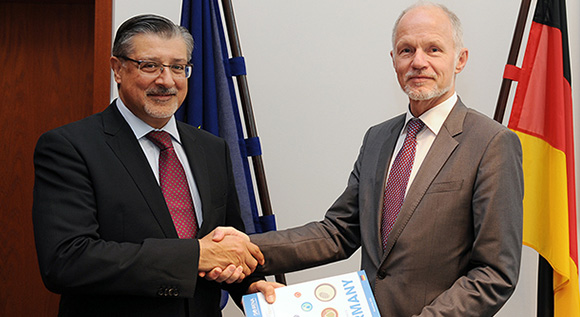Well on track on renewables
Germany will be able to rely on ever-greater shares of solar and wind energy. This was confirmed by a recent study conducted by the International Renewable Energy Agency (IRENA). The study found that there is room for greater use of renewables, especially in the heating and transport sectors.
 © BMWi
© BMWi
Germany is well on track to meeting its renewables targets. This is one of the key findings of a study conducted by the International Renewable Energy Agency (IRENA) which was published on 10 November 2015. The targets that Germany has set itself are ambitious, with 45 per cent of the country’s electricity use to be covered by renewables including wind and solar energy by 2025. By 2035, this figure is to rise to no less than 60 per cent.
Five times more green electricity than in 2000
The share of renewables in Germany’s electricity consumption has skyrocketed since the beginning of the millennium. In the first half of 2015, green energy accounted for approx. 32 per cent of demand, compared to 6 per cent in 2000. Generation capacity has also increased quite considerably, from 12.3 gigawatts in 2000 to 85 gigawatts in 2013. That’s almost seven times as much.
Adnan Z. Amin, Director-General of IRENA, said: “Germany’s rapid renewable energy expansion and ambitious targets have demonstrated to the world that a 30 per cent share of renewable power is possible. However, to meet even higher shares and continue building one of the world’s most energy-efficient, sustainable and low-carbon energy systems, Germany must now expand its focus beyond the power sector.”
Where the potential is: heating and transport
According to the IRENA study, the key to further boosting the share of renewables is to be found in the heating and transport sectors, where heat pumps, solar thermal installations, and greater use of biomass could make a real difference. IRENA has also spoken out in favour of ‘sector coupling’, which essentially means using electricity for heating purposes and in transport.
Let’s take an example from the heating sector: If you have a house built in Germany, you are required under the Renewable Energy Sources for Heating Act to ensure that at least some of the energy used for heating comes from renewables. The German government has also created a special Market Incentive Programme called ‘MAP’. The aim of this programme is to encourage even greater numbers of home owners, firms, and municipalities to opt for installations that use solar energy, biomass, and geothermal energy for heating. More specifically, the programme promotes the use of the latest solar thermal energy installations, heating systems that use biomass as a fuel, and heat pumps. This spring, the government revisited the programme to make it even more attractive.
Both the regulation for new buildings and the Market Incentive Programme are proving to be effective: Between 2009 and 2013, the amount of green energy used for heating and cooling purposes increased by almost a third. And it is likely that the 14-per-cent target set out in the Renewable Energy Sources for Heating Act will be surpassed, with green energy sources on track to account for 16.3 per cent of the final energy used for heating and cooling purposes in 2020.
Transport is another area covered by IRENA’s report. It says that renewables accounted for 5.6 per cent of the fuel used in the German transport sector in 2014. In this context, ‘renewables’ is almost synonymous with biofuels, which are used to power cars, trucks, trains, ships, and aeroplanes. But renewables are also becoming ever more important when it comes to powering electric vehicles. Electric mobility is low-carbon mobility and helps to bring electricity from renewable sources, such as solar and wind energy, into the transport sector.
Milestones: electricity market 2.0 and digitisation
The IRENA report highlights the benefits of cross-border cooperation between Germany, its neighbours, and its European and international partners. The energy transition could pick up even more speed if additional regional transmission capacities were created and if renewables were given a stronger role in the international efforts to mitigate climate change. For this to happen, the electricity markets would have to get ready to take in growing amounts of intermittent renewable energy.
Germany is a frontrunner on this. Just a fortnight ago, the Federal Cabinet adopted draft legislation that will upgrade the electricity market to an ‘electricity market 2.0’, and allow the energy transition to go digital. State Secretary Rainer Baake said: “By deciding in favour of the Act on the Further Development of the Electricity Market, we have set the regulatory framework for the German electricity market of the future. Our future market design will meet the challenge of synchronizing conventional and renewable electricity.” He went on to explain that it was important for Germany to closely coordinate with its neighbours and with the European Union on this challenge. He said that the report published by IRENA showed that further integration of the electricity, heating and transport sectors would be needed to further expand the share of renewables. The Act on the Digitisation of the Energy Transition, he said, was an important milestone in this process.
2015 set to be another record year
Yet more evidence of the fact that Germany is well on its way to meet its renewables targets comes in the form of the projections for 2015. The Baden-Württemberg Centre for Solar Energy and Hydrogen Research (ZSW) and the German Association of Energy and Water Industries (BDEW) expect the share of renewables to reach 33 per cent of Germany’s electricity consumption this year. That would be an all-time high.

